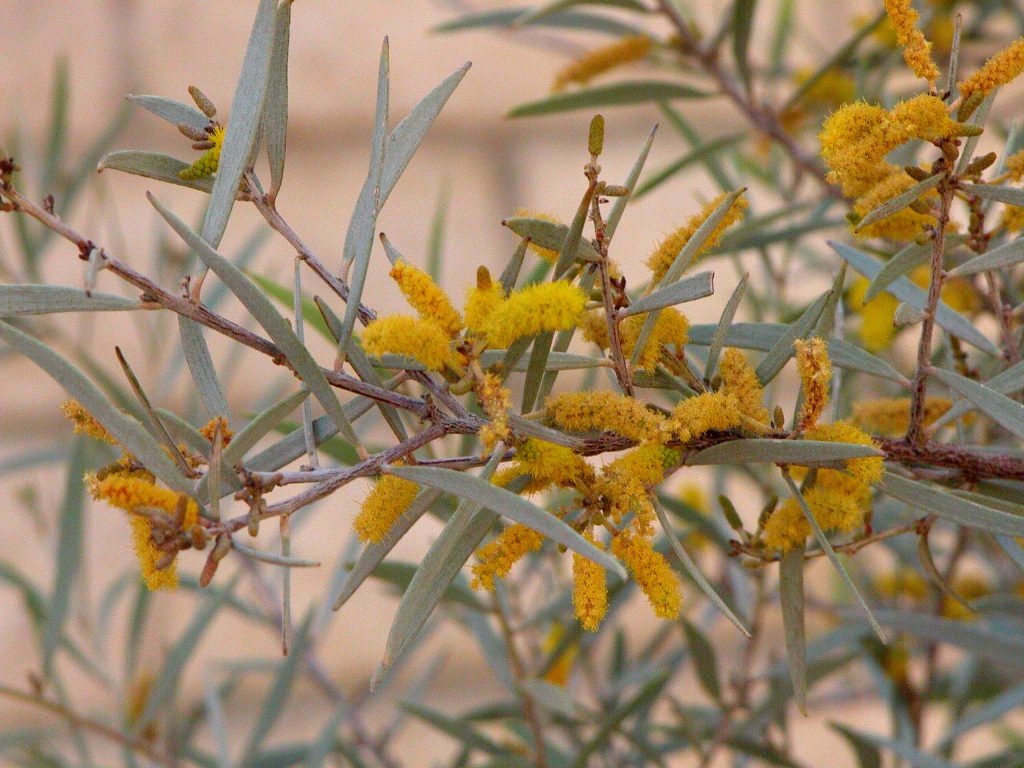Acacias include a diverse group of arid region landscape plants ranging from trees to shrubs to groundcovers. Acacias offer shade, screening, and spectacular flower shows for your landscape, depending upon the plant selected. They are primarily full sun plants and tolerate a variety of soil conditions. Tree acacias require infrequent, yet periodic deep watering to develop a healthy root system. This is done by watering along the edge of the canopy and not at the base of the trunk. All Australian acacias have modified leaf stems called phyllodes, which are commonly thought to be their leaves, and perform the same functions as the leaves. The acacia pictured to the right is of the mulga variety. Note that many of the Acacia’s have been recently reclassified to the genus Vachellia.
Choosing the Acacia That’s Right for Your Landscape
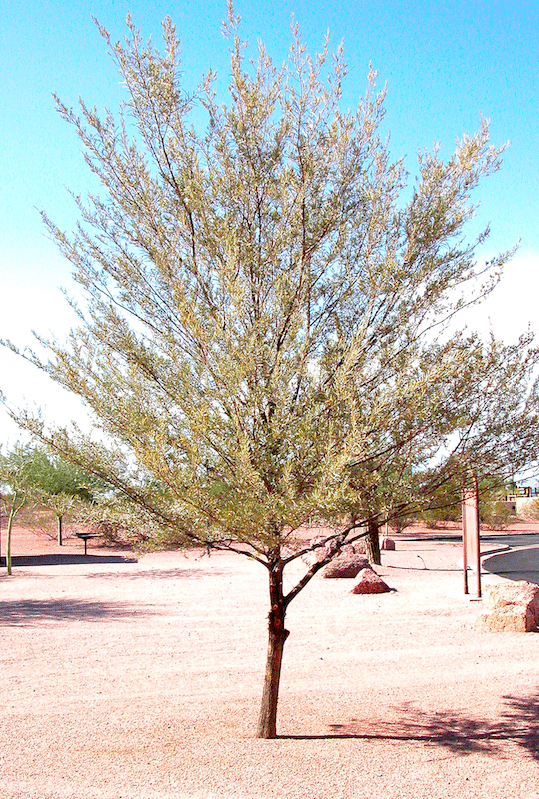 Acacia aneura, Mulga
Acacia aneura, Mulga
Native to Australia, this evergreen shrub or small tree grows to about 20 feet tall by 15 feet wide. Mulga has leathery, gray-green to silvery leaf-like phyllodes (as described above) and blooms in the spring with small rod-shaped golden yellow flowers. See our featured photo above for the golden flowers in full bloom. It is thornless, low maintenance and low litter, and makes an attractive evergreen screen or a small accent or patio tree.
Acacia farnesiana, Sweet Acacia
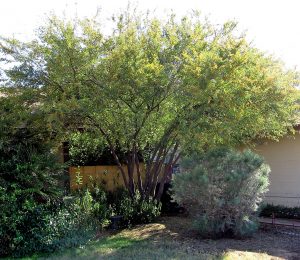 An excellent shade tree, sweet acacia reaches a height of 20 feet. Sweet acacia flowers profusely in the winter to early spring with fragrant, yellow puffball flowers. It is especially suited for patios and small yards. Sweet acacia is semi-deciduous and cold-hardy to 12 degrees Fahrenheit. This thorny tree is native to the southwestern United States. The thorns are not as prominent on the older growth. Initial maintenance requires that suckers be pruned from the base of the trunk. Sweet acacia is also sold under the names of Acacia smallii and Acacia minuta.
An excellent shade tree, sweet acacia reaches a height of 20 feet. Sweet acacia flowers profusely in the winter to early spring with fragrant, yellow puffball flowers. It is especially suited for patios and small yards. Sweet acacia is semi-deciduous and cold-hardy to 12 degrees Fahrenheit. This thorny tree is native to the southwestern United States. The thorns are not as prominent on the older growth. Initial maintenance requires that suckers be pruned from the base of the trunk. Sweet acacia is also sold under the names of Acacia smallii and Acacia minuta.
Acacia salicina, Willow Acacia
This semi-weeping acacia tree grows 25 feet high and up to 15 feet wide with long, slender, blue-green, willow-like foliage and small, creamy puffball flowers in the spring. Willow acacias evoke a cool oasis effect in the landscape, and are useful as screening trees. They are evergreen and native to Australia. See link for photos.
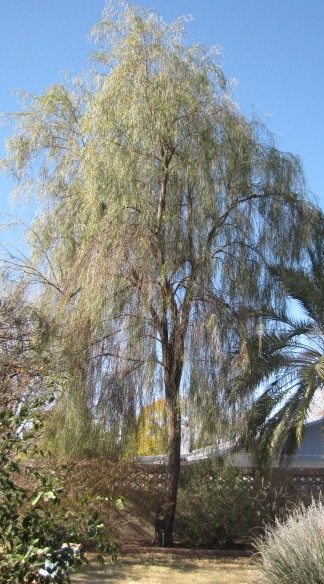 Acacia stenophylla, Shoestring Acacia
Acacia stenophylla, Shoestring Acacia
This slender, upright tree may eventually grow to 30 feet in height with weeping, shoestring-like phyllodes and cream colored puffball flowers. Shoestring acacia makes a fine specimen tree or may be grouped in small groves as a visual screen. It is evergreen and native to Australia. Due to its low litter, this tree is commonly recommended for pool areas. One of the many values of this plant is its ability to cast shadows that provide filtered shade for yards and structures.
Acacia willardiana, Palo Blanco
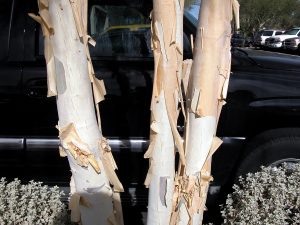
The words “Palo Blanco” mean “white stick” in Spanish and refers to the white trunk of this tree, which is considered to be one of its most attractive assets. This small, slender tree grows 10-20 feet high with a spread of 5-10 feet and works great in residential yards or narrow planting areas. This thornless acacia has weeping branches, bright green foliage with tiny leaflets and blooms in the late spring with white flower catkins. It will drop many, but not all of its leaves in winter and is native to Mexico’s Sonoran Desert. In larger spaces, try planting this tree in groups of three or five for a striking grouping. See link for additional photos.
One final note about Acacias: At Water – Use It Wisely, we completely agree with concerns about exotic plants that become invasive and cause environmental harm. Based on feedback from some of our readers, we have consulted with Matthew Johnson with the University of Arizona Desert Legume Program. He acknowledged that many of the Australian species of Acacia have naturalized in California and become one of many plants causing fire concerns there. However, all of the species that we have highlighted have not naturalized (become invasive) in Arizona, and our plant information on our site and included in our blogs is primarily designed for low-desert Arizona gardeners.
The Acacias are a family of plants that have species that have originated in many parts of the world. There are African, Australian, and South Asian species, and of course, even many from North and South America. While our Plant of the Month did feature three species from Australia, we also feature two from North America. In fact, one is native to our Sonoran Desert.
We encourage anyone who is selecting plant material for their landscape to check and make sure that the species they choose will not cause the threat of being invasive and environmentally damaging in their area.
Did you know that up to 70 percent of water use is outdoors? That’s why we love desert plants and feature them each month. It’s still a great time to plant, and you can learn more about Acacia’s and other plants on our Arizona Low-Water-Use Plants page or past Plant of the Month blogs. Visit our page on Choosing and Planting Low Water-Use Plants for tips on plant selection and how to plant properly.
This feature is based on a concept and text originally developed jointly by the Arizona Nursery Association and the Arizona Municipal Water Users Association (AMWUA) with partial funding from the Arizona Department of Water Resources. Learn more about these and other great desert plants at the Arizona Municipal Water Users Association Landscape Plants for the Arizona Desert plant database, or see our previously featured Plant of the Month blogs. Donna DiFrancesco is the photographer of all the photos in this blog.


